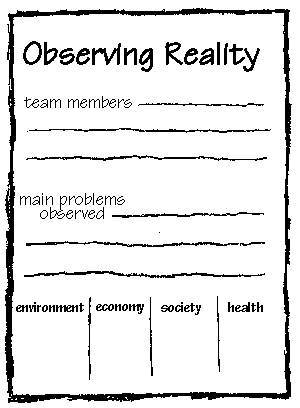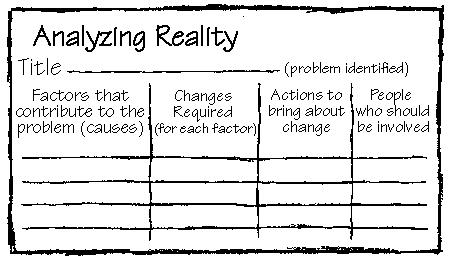


- To identify the main challenges set out in Rescue Mission Planet Earth.
- To identify problem situations in the community related to the environment, health and development.
- To develop analytical skills with respect to human development practices contributing to these problems.
- To identify strategies for contributing to sustainability in the community.
- To implement a community action plan designed to promote sustainable development.
The students should complete the activity Defining a Sustainable Future on page 12 and share their ideas.
In groups, students should prepare an observation grid (see example on page 9) with four headings: environment, economy, society and health.
Under these headings, students select one or more issues from Agenda 21 and Rescue Mission Planet Earth which have applications in the local community (e.g. waste management, Chapters 19-22), prepare a brief explanation of the reason for selecting it, and present it to the class.
The class should agree on a list of topics most relevant to their community.Each group selects a topic for investigation in the community.

In groups, students undertake a Journey of Discovery to report on aspects of the selected issues in the local community and, as far as possible, some of the causes of the problems. Students can fill in the observing reality chart (based on their journey).
Their task is to observe, note questions as they arise, draw links between their reality and the challenges presented in Agenda 21 and Rescue Mission Planet Earth, and make a note of issues that could be the focus of community action.
Once back in the classroom, after the journey of discovery, the teams report their observations to the full group. The class should pick out the main problems encountered in the community and identify those that most urgently require action.
For each problem selected for discussion, students should prepare a table with four columns, based on the example analyzing reality on page 11.
During this step it may be possible to identify, at the outset, a problem that is common to the entire class. This option makes it possible to move on more quickly to the transforming reality step.
Students should suggest one or more activities which they might undertake to contribute to solutions. The activities should be manageable in terms of the students' time and effort and should have the potential for achieving recognizable benefits. Students then carefully plan the steps in the activity to be undertaken. Use the Community Action Plan on page 7 and check off the boxes for steps 3, 4, and 5. The analyzing reality chart may help students to organize the process and help in the evaluation of their work.
After the community activities, students should report to the whole class and use step 7 of the Community Action Plan to evaluate their project.
Students can use photographs, drawings, texts, and poetry to illustrate Agenda 21 as reflected in their own community, to make a presentation on the progress and results of the class activity.
Throughout the process, students could prepare texts outlining the situations encountered or publish opinion pieces in student papers or local newspapers.
Finally, it is suggested that the results of your community action plan be disseminated on the Canadian SchoolNet.
